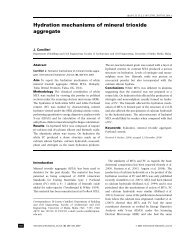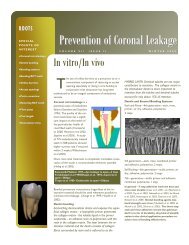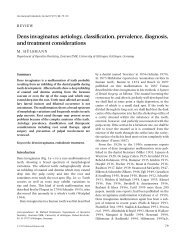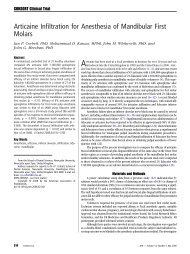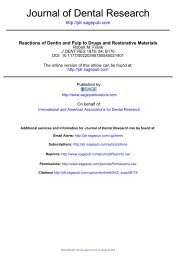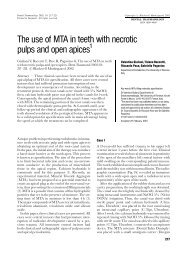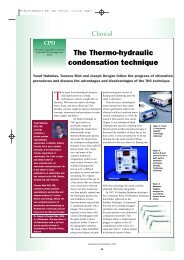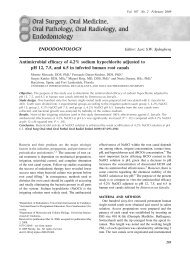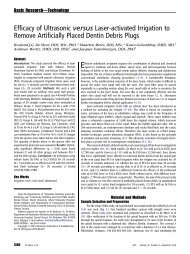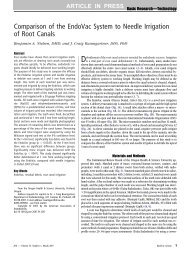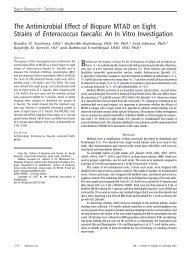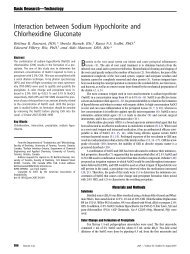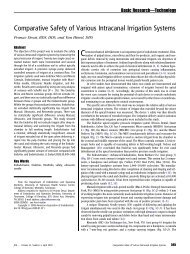A Century Of Endodontics: From Philadelphia To Boston - The ...
A Century Of Endodontics: From Philadelphia To Boston - The ...
A Century Of Endodontics: From Philadelphia To Boston - The ...
You also want an ePaper? Increase the reach of your titles
YUMPU automatically turns print PDFs into web optimized ePapers that Google loves.
Photo courtesy of the University of Pennsylvania Archives<br />
Dr. David Walter Cohen<br />
tistry was in the process of crystallizing in<br />
<strong>Boston</strong>. <strong>The</strong> venture would be grounded<br />
on a sound biological rationale with close<br />
cooperation between dental medicine and<br />
total health. It was led by Henry M. Goldman,<br />
DMD, a 1935 graduate of Harvard<br />
Dental School who returned from the service<br />
in 1945, where he had served as the<br />
first chief of the dental pathology section<br />
at the Armed Forces Institute of Pathology<br />
for the United States Army. 13<br />
Harvard Dental School transformed<br />
itself into the Harvard School of Dental<br />
Medicine in 1942. <strong>The</strong> university envisioned<br />
a small group of dental scientists<br />
with an additional degree (MD or PhD),<br />
who would train the students to become<br />
future educators and researchers. It used<br />
the Johns Hopkins Medical School model<br />
from 1883 as its working standard. 14<br />
Dr. Goldman, not having advanced degrees,<br />
did not find a place in this new<br />
paradigm. However, a prominent physician,<br />
Dr. Jacob Fine from the Beth Israel<br />
Hospital staff, invited him to use its small<br />
dental clinic as a teaching facility.<br />
During 1946, Dr. Goldman began his<br />
association with the faculty of the University<br />
of Pennsylvania by joining Drs. Lester<br />
Burket, LeRoy Ennis, and E. Howell Smith<br />
on the Ivory Cross expedition to Holland.<br />
<strong>The</strong> purpose of this venture was to<br />
bring new dental knowledge to countries<br />
that had suffered under the Nazi regime.<br />
Dr. Goldman had known Dr. Burket, an<br />
oral pathologist, during the mid- to late<br />
1930s while Dr. Burket was acquiring<br />
his medical degree from Yale University.<br />
<strong>The</strong> trip introduced the young Harvard<br />
graduate to both the international education<br />
and the worldwide travel that would<br />
become essential components in establishing<br />
the future school. 13<br />
As the Beth Israel dental clinic grew,<br />
Dr. Goldman took a number of yearlong<br />
residents in periodontics. One of the earliest<br />
was Dr. David Walter Cohen, a recent<br />
graduate of the Penn dental school.<br />
Dr. Cohen returned to Penn in 1951, was<br />
named head of the first Department of<br />
Periodontics in 1956, and was named<br />
dean in 1972. Through the efforts of<br />
Dean Burket, the Beth Israel Hospital<br />
program established official links with<br />
the Penn dental school by creating a<br />
unique two-year postgraduate program<br />
in periodontology with Dr. Goldman as<br />
its director. <strong>The</strong> didactic year was spent<br />
at the Penn Graduate School of Medicine<br />
and the clinical year at the Reisman<br />
Clinic at Beth Israel. 13 Under this format,<br />
Dr. Goldman’s students earned certificates<br />
of distinction from a major university<br />
and became eligible to earn a<br />
master’s degree and potential diplomate<br />
status from the American Board of Periodontists.<br />
On the advice of Dr. Philip Shupack,<br />
a classmate who trained in periodontics<br />
at Beth Israel, Herbert Schilder, DDS, a<br />
young graduate of New York University<br />
Dental School who was serving a<br />
two-year Army commitment in Aberdeen,<br />
Maryland, called upon Dr. Goldman at the<br />
Beth Israel clinic in 1955. Dr. Goldman advised<br />
and directed the aspiring endodontist<br />
to seek additional training at the University<br />
of Pennsylvania with Dr. Grossman and<br />
then to return to Beth Israel. Even though<br />
Dr. Grossman had not yet formed an official<br />
postdoctoral program, he invited<br />
Dr. Schilder to attend his short courses<br />
while still in the military. 15<br />
Dr. Cohen, who was also a lecturer<br />
in periodontics at Temple Dental<br />
School beginning in 1953, was familiar<br />
with the one-year residency program in<br />
endodontics at that school. <strong>The</strong> Department<br />
of <strong>Endodontics</strong> at Temple had been<br />
established in 1948 by Dr. Morton Amsterdam<br />
and a fellow Penn dental school<br />
graduate. With the 1954 death of Tufts<br />
endodontist Dr. Bernard Berg, Dr. Goldman<br />
needed a new clinician. At a continuing<br />
education course, Drs. Cohen<br />
and Schilder discussed the latter’s future<br />
as a root canal therapist. Since there was<br />
no official postdoctoral program at Penn,<br />
Dr. Herbert Schilder<br />
Dr. Cohen called Dr. Amsterdam, who,<br />
after interviewing Dr. Schilder, offered<br />
him the endodontic residency at Temple.<br />
Dr. Schilder would also have the opportunity<br />
to complement his education with<br />
Dr. Grossman through Penn’s yearlong<br />
short courses. Dr. Amsterdam impressed<br />
upon Dr. Schilder the need to attend and<br />
actively participate in the yearly meetings.<br />
<strong>The</strong> latter planned to return to <strong>Boston</strong>,<br />
where his wife had attended Wellesley<br />
College. 16<br />
Upon completion of Dr. Schilder’s<br />
year in <strong>Philadelphia</strong> in 1956, Dr. Goldman<br />
secured office space at 53 Bay State<br />
Road in <strong>Boston</strong> so that Dr. Schilder could<br />
open a private practice. Dr. Goldman also<br />
offered him a teaching position at the<br />
Reisman Clinic at Beth Israel. <strong>The</strong> nucleus<br />
for the future <strong>Boston</strong> University School of<br />
Graduate Dentistry was now in place.<br />
As a role model, Dr. Goldman urged<br />
his staff to publish, lecture here and<br />
abroad, and teach. <strong>The</strong> purpose was to<br />
develop a more advanced institution that<br />
would benefit the profession. As Dr. Schilder<br />
became more experienced, he became<br />
an advocate of specialty education within<br />
the AAE, where he served as president<br />
in 1985, as well as in the ADA, where<br />
he held the office of first vice president<br />
in 1990. Unlike Dr. Goldman, who was<br />
known for publishing numerous texts<br />
(many with Dr. Cohen), Dr. Schilder,<br />
out of deference to Dr. Grossman, never<br />
wrote a textbook on endodontics.<br />
By 1958, Dr. Schilder was head of<br />
the endodontic section of the department<br />
of stomatology at <strong>Boston</strong> University<br />
School of Medicine and accepted his first<br />
postdoctoral student, Dr. Cyril Gaum, in<br />
1960. 17 In 1963, Dr. Schilder became a<br />
founder, associate professor, and chair<br />
of the Department of <strong>Endodontics</strong> at the<br />
School of Graduate Dentistry at <strong>Boston</strong><br />
University.<br />
Dr. Bernard Berg’s earlier work with<br />
chloropercha had piqued Dr. Schilder’s<br />
curiosity. 18 Over the next several years,<br />
Dr. Schilder gradually developed a warm<br />
gutta-percha technique employing Kerr<br />
sealer and vertical compaction to obturate<br />
the root canal system; this technique<br />
influenced the profession and changed<br />
the face of modern endodontics. <strong>The</strong> triad<br />
of cleaning, shaping, and filling took on<br />
new meaning. 19 Schilder eventually retired<br />
from teaching in April 2003.<br />
In a tribute to Dr. Schilder upon<br />
his death in 2006, Dr. Joseph Williams<br />
wrote of his teacher, partner, and longtime<br />
friend: “He was ‘<strong>The</strong> Professor’ to<br />
hundreds of graduate students and thousands<br />
of dentists around the country and<br />
the world. . . . Herb Schilder changed the<br />
stature of modern endodontics for the<br />
better. Patient care, results of treatment,<br />
education of practitioners, and understanding<br />
of the specialty have all benefited<br />
from his influence. Herb’s genius was<br />
his ability to articulate very complicated<br />
concepts and techniques into easily understood<br />
vernacular.” 20<br />
In 1999, Jeffrey W. Hutter, a graduate<br />
of the Penn dental school, assumed<br />
the mantle as the first Herbert Schilder<br />
Chair in <strong>Endodontics</strong> at <strong>Boston</strong> University.<br />
Dr. Hutter spent his professional<br />
career in the Navy, culminating as chair<br />
and director of postdoctoral endodontics<br />
at the Naval Dental School in Bethesda,<br />
Maryland. In 2008, he became dean and<br />
the first Spencer N. Frankl Professor in<br />
Dental Medicine at <strong>Boston</strong> University’s<br />
Goldman School of Dental Medicine.<br />
During 2009, Dr. Hutter appointed George<br />
Huang, DDS, MSD, DSc, a Taiwan native<br />
and former student of Dr. Schilder, as the<br />
second Herbert Schilder Chair in <strong>Endodontics</strong>.<br />
21<br />
Summary<br />
While Dr. Grossman was in Rostock with<br />
a letter of introduction from Dr. Prinz,<br />
he visited several distinguished dentists<br />
in Berlin. One was the aged Dr. Otto<br />
Walkoff, who, with the help of a physicist<br />
while in Wurzberg, was the first dentist to<br />
capture the image of a tooth soon after<br />
the discovery of radiology by Roentgen<br />
in 1895. At his home, Dr. Walkoff passed<br />
the X-ray tube head that had taken the<br />
historic film to Dr. Grossman, who then<br />
held this treasured artifact in his hands. 2<br />
This transfer of culture from Germany to<br />
the United States marked the beginning<br />
of modern endodontics. Similarly, when<br />
Dr. Goldman gave Dr. Schilder his backing<br />
by sending him to study under Dr. Grossman<br />
at the University of Pennsylvania,<br />
the progress of endodontic excellence<br />
moved forward, ensuring a <strong>Century</strong> of<br />
<strong>Endodontics</strong>. <br />
References<br />
1. Grossman LI. Curriculum vitae. J Endodont.<br />
1982;8:S5.<br />
2. Editorial. Dr. Louis I. Grossman—the father of<br />
endodontics. J Endodont. 1984;10(4):170.<br />
3. Asbell M. A century of dentistry: a history of<br />
the University of Pennsylvania School of Dental<br />
Medicine. <strong>The</strong> Trustees of the University of<br />
Pennsylvania; 1977. p. 132.<br />
4. Cohen S, Burns R. Pathways of the pulp. 3rd<br />
ed. St. Louis (MO): Mosby; 1983. p. 1.<br />
5. Grossman LI. Curriculum vitae. J Endodont.<br />
1982;8:S6.<br />
6. Delany JJ, Adams B. <strong>From</strong> cradle to cutting<br />
edge. Penn Dent Jour. University of Pennsylvania<br />
School of Dental Medicine. 2007;4(1):3-5.<br />
7. Grossman LI. History of the <strong>Philadelphia</strong><br />
root canal study club: 1939. J Endodont.<br />
1982;8:S41-42.<br />
8. Grossman LI. American Association of<br />
Endodontists: birth in 1943. J Endodont.<br />
1982;8:S43-45.<br />
9. Grossman LI. <strong>Endodontics</strong> 1776-1976: a<br />
bicentennial history against the background of<br />
general dentistry. JADA. 1976;93:87.<br />
10. Bender IB. Comments. 40th anniversary of the<br />
Penn postdoctoral endodontics. Video biography.<br />
<strong>Philadelphia</strong> (PA); 1989.<br />
11. Ostrander FD. <strong>The</strong> practice of endodontics: past,<br />
present, and future. J Dent Ed. 1967;31(3):388.<br />
12. Asbell M. A century of dentistry, a history of<br />
the University of Pennsylvania School of Dental<br />
Medicine. <strong>The</strong> Trustees of the University of<br />
Pennsylvania; 1977. p. 11-18.<br />
13. Cohen DW. A tribute to Henry M. Goldman,<br />
DMD. Compendium. 1994;18:S657-660.<br />
14. Chesney AM. <strong>The</strong> Johns Hopkins Hospital<br />
and the Johns Hopkins University School of<br />
Medicine: a chronicle: early years, 1867-1893.<br />
Baltimore (MD): Johns Hopkins Press; 1943.<br />
p. 1:viii-ix.<br />
15. Schilder H. Video biography. Goldman School<br />
of Graduate Dentistry, <strong>Boston</strong>; 1991.<br />
16. Cohen DW, Amsterdam M. In memoriam.<br />
J Endodont. 2006;32(4):382.<br />
17. Millstein C. Defining a specialty. J Mass Dent<br />
Soc. 1995;44(2):16-17, 33.<br />
18. Berg B. Endodontic management of multirooted<br />
teeth. Oral Surg Oral Med Oral Path.<br />
1953;(6):3.<br />
19. Schilder H. Filling root canals in three<br />
dimensions. Dental clinics of North America.<br />
<strong>Philadelphia</strong> (PA): W.B. Saunders; 1967; p.<br />
723-724.<br />
20. Williams J. Remembering “<strong>The</strong> Professor.”<br />
J Mass Dent Soc. 2006;55(2):16-17.<br />
21. Hutter, JW. Biographical statement. February<br />
2010.<br />
<strong>The</strong> Henry M. Goldman School of Dental Medicine building at 100 East Newton Street in <strong>Boston</strong><br />
24 Journal of the Massachusetts Dental Society Vol. 59/No. 2 Summer 2010 25



